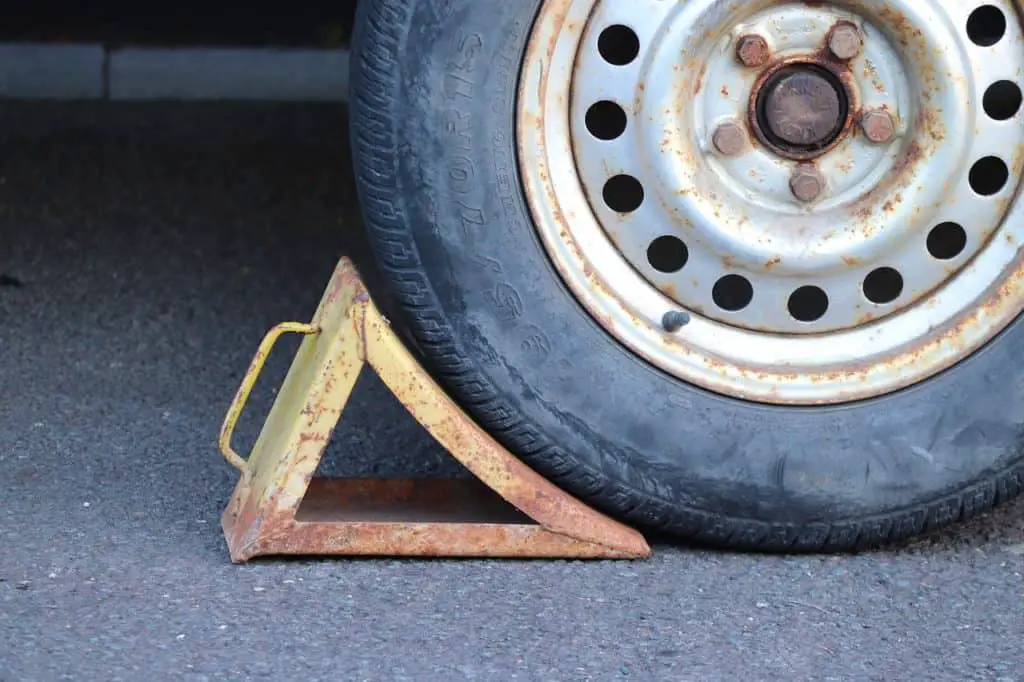One of the most common issues you may run into as you travel down the road is going to be a flat tire. A flat tire on your horse trailer may seem like a daunting problem to resolve but this article should help you get back on the road.
If the tire goes flat on your horse trailer you need to either patch the hole or swap it out for a spare much like you would on any car or truck. The big difference here is that you are going to want to first make sure that your animals are safe and keep them in the trailer!
With the proper precautions, you should be on the road in no time. Below I will walk you through everything you need to know to keep you and your horse is safe.
Steps to safely change your horse trailer tire.
If you’ve never changed a tire before the process could seem a little bit daunting but it’s actually quite easy as long as you take your time and make sure you follow the steps below.
1. Get to a safe place and check on your animals.
When you realize that you had a blowout one of the first things you want to do is find a safe place to pull over if you’re on a major interstate try to pull slowly to the next exit the last thing you want to do is be hit trying to change a tire.
Take a peek into the trailer and make sure that the horses look like they are okay. If that’s the case leave them alone. They are likely already stressed out from the noise and probable shaking that happend when the tire blew.
2. Setup a safe working area
Also in the vein of improving safety, you’re going to want to set up some roadside flares in a diagonal pattern towards the middle-of-the-road and turn on your hazard lights.
This process helps other drivers see that there’s danger ahead. If you don’t already have roadside flares in your trailer toolbox I highly recommend these awesome LED hazard puck lights from Amazon. They are practically indestructible and can be seen from a very long way away.
Next, you are going to want to make sure that your trailer is not going to move. Chock your tires on both the truck and the trailer. Tire chocks are best for this but if you don’t have any, rocks and large sticks can be used instead. As an added safety measure, turn on your parking brake, leave the trailer attached to the tow vehicle, and put the keys into your pocket.

3. Gather your tools.
Collect all of the tools your going to need. Including a jack, and a tire iron.
Using the tire iron, remove the spare tire for your trailer. Most of the time these are attached by a set of the same size lugs as your trailer has. Sometimes these will have a locking nut, your trailer should have come with a key to unlock that first. It’s best to do this while the trailer is still on the ground.
4. Replace the tire
Using that same tire iron loosen the bolts on the damaged tire. Do not completely remove them. Just get them loose, the weight of the trailer will help stop the wheel from moving.
Next, you are going to want to jack up the damaged tire. This can be done with just about any jack rated for your trailer PLUS the weight of the horses. If math isn’t your thing just go BIG they aren’t really that much more expensive. For example, this 12t bottle jack is only about 30$ on amazon. Just make sure that your jack will fit under your trailer!
Pro tip: Jack your trailer from the axle, not the frame. This ensures that all of that weight is distributed where it’s meant to be and you won’t damage your trailer.
An alternative to a jack if you have a tandem axle trailer is a Trailer aid. These are basically ramps designed to hold the weight of your trailer. Instead of jacking the trailer up, you drive the good tire onto the ramp, lifting the bad tire off the ground. As with most things, these can be found on amazon. They are supposed to be a real timesaver; however, I have not personally had the pleasure.
Remove the damaged tire. Now you can take those loosened lug nuts off and put them into a safe place you do not want to lose these.
Lift your spare tire onto the studs and hand tighten the old lug nuts to hold the tire in place.
In a star pattern, tighten all the lug nuts so that the spare sits flush with the hub.
Slowly lower the jack to the ground. For this step make sure there are not any hands or feet that might get caught under a tire.
5. Clean up.
Now that your trailer is safely on the ground, give the lug nuts another go and make sure that they are tight. The last thing you want is to lose your spare going down the road.
Attach your damaged tire to your spare tire mount, or toss it in the bed of your truck. Just make sure you don’t forget it so that you can have it replaced or repaired at a tire shop.
Clean up. Pull your chocks, pickup your hazard lights or road flares, and head back down the road. One important note, your spare tire may have a maximum rated speed. If that’s the case it should be listed on the side of the tire.
Video Lesson!
I’m a bit more of a visual learner so I’m including this video explaining the above process. In this case, he’s not changing the tire of a horse trailer but the same principles apply.
Is there someone I can call?
For some people, taking the DIY approach may not be the best option. If you have planned ahead you could call an equine roadside assistance company. But they often have a 24hr lead time before they become active.
UsRider.org Is one such service that offers help in these types of situations. They even have places you can stay overnight across the country if that becomes necessary.
AAA will help replace your trailer tire but they will also require that you remove the animals from the trailer before they help with your flat. If it’s more serious though they will not tow your trailer if such an event arises.
Packing a trailer toolbox BEFORE you leave.
If you’re going to be traveling any decent distance with your horse trailer you should really prepare ahead of time. There are quite a few things you can do before the emergency that will really save you a ton of headache.
I like to keep a toolbox in my trailer designed to help me out in these kinds of situations. Often times people mount a tongue box to their trailer for safely storing these items. Just make sure it will fit on the tongue of your trailer.
You should pack the following items somewhere safe on your trailer or in your tow vehicle. Personally, I would keep mine on the trailer it’s self so that it’s always there no matter the tow vehicle.
- Tire Iron
The tire iron on your truck might not be the same size as the one in your trailer. I recommend keeping a four-way tire iron as it should fit any vehicle or trailer that needs an emergency change. They also allow for a ton of force to be applied due to their shape. - Roadside Flares
In any emergency where you are stuck on the side of a road, it’s important to be as visible to other drivers as possible. As I mentioned earlier, I really like these LED hazard puck lights from Amazon. They are very bright, magnetic, waterproof, and pretty much indestructible. - Jack or Trailer Aid
This one is pretty obvious, in the event of a tire issue you’re going to want to be able to lift the trailer in some way so that you can make repairs. When in doubt here a higher weight rating is usually better. Just make sure that the jack fits under your trailer! - Wheel Chocks
Safety first! Wheel chocks help prevent the vehicle or trailer from moving. having your jack tip because the trailer moved on you is zero fun. Trust me. - Rachet straps
These will probably not be used too often but having strapping on hand is never a bad idea. Sometimes tire blowouts can be quite violent and can even cause damage to your trailer. These would be very helpful in temporarily holding fenders or other decorative parts of your trailer back where they belong, or at least out of the way. - First Aid Kit
I don’t know about you but I’m kind of clumsy especially if I’m stressed out about being next to moving traffic. Also, sheet metal can be quite sharp! - Pair of mechanics gloves
In an effort to protect my hands from both injuries and just help to keep them clean I like to keep a pair of cheap mechanics gloves in my kit. - Tire Patch kit
Sometimes you can get away with patching the damaged tire without pulling it off the trailer. Kits such as this one from amazon are fairly cheap and include everything you should need to repair a small hole. - 12v air compressor
If you patch your tire you likely need to add a little air. A 12v air compressor will get you back on the road in no time. Make sure you get one with an extension hose or electrical adaptors so that you can reach your trailer tires to fill them up. This 12v compressor has both and should be a good choice. - Extra lead ropes and halters.
If your traveling with horses it makes sense to throw some horse tack into your horse trailer. I like to keep an extra set of lead ropes and halters for each horse so that I have plenty to spare if I need them.
Why shouldn’t I unload my horses?
Earlier I mentioned that you should not unload your horses from your trailer while changing a flat tire. You may be asking yourself why that would be the case.
In most cases leaving your horses inside of the trailer is going to be the safest option. Horses and moving traffic often don’t mix well, there’s a lot of noise and a lot of stress for your animals that could cause them to act up in runaway possibly into oncoming traffic.
This does however leave you open to the chance that they will move inside of the trailer causing it to fall off of its Jack. However I don’t think that this is going to be a major issue. If you are really worried about it you could pick yourself up some jack stands and set them up underneath the trailer once it is jacked up.
If you happen to be at a location such as your home for another place where you might have access to a stall or a paddock, you should unload your horses as either of those would be the best option. That would not only keep your animals safely contained but there’s also no chance that they will cause the trailer to move off of Jack.
